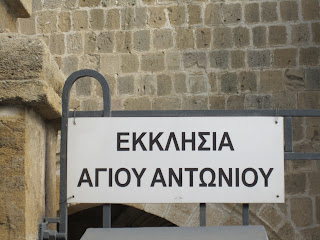I am enjoying this trip to Cyprus at the invitation of my friend and colleague, Michalinos Zembylas. We each earned our Ph.D. at the University of Illinois, Urbana-Champaign, meeting in one of the first classes and establishing a strong and lasting relationship from the first day. That relationship was built around a shared love of coffee and of lengthy discussions on what we were learning; it has grown over the past 7 years on collaborative research and writing projects. I credit much of my success at tenure to Michalinos' brilliant and prolific writing, both of which pushed me to be and do more than I imagined possible. Coming to Cyprus and working on our current project, an exploration of forgiveness pedagogy with Cypriot teachers, is a delight for me. Meeting his wife, Galatia, and their two children, Orestes (5) and Mariza (3) is equally a delight!
 |
| Michalinos, Orestes, and Mariza |
 |
| Galatia and children, playing with the toys I brought for them--toys all made in China! |
 |
| Orestes (AKA Superman) looks just like Michalinos, Mariza looks just like Galatia! |
 |
| Village of Galata, Cyprus |
The villages are shrinking as young people move to urban areas. Michalinos' mother, Maro, who is involved in village politics, said (with Michalinos tranlating for me), that the village leaders are trying to close the local school. When Michalinos attended in the late 1970s-80s, there were 150 students. Now there are 20. Maro is fighting to keep the school open, as losing it will further diminish the life of the village and the possibility of luring young people back.
Mara prepared an amazing Cypriot Sunday family meal, including dolmasi (meat and rice wrapped in cabbage leaves), wild mushrooms (that Michalinos' father, Andreas, found on the mountains), souvlas (grilled lamb, chicken, and potatoes), a vegetable that I think was pickled caper plant, the ever present yoghurt, lemons, and olives, and village salata with lettuce, tomatoes, cucumbers, and feta cheese. This was followed by enormous strawberries, the best I've ever tasted, a cream dessert of some sort, and a pistachio ice cream cake, served in honor of my birthday!
After dinner I sat with Andreas and looked a book filled called "Morphou--A Cry of Anguish". It was filled with poetry and pictures of Morphou, the city wher he and his family lived until the Turkish invasion of the north in 1974. At that time they fled as refugees to Galata (Michalinos was 5), leaving their homes, churches, lands, memories to others, just as Turkish Cypriots were forced to abandon theirs in the south and relocate in the north of Cyprus. The country remains partitioned, with Nicosia one of the last divided cities in the world. Andreas showed me pictures of their home and church, included in this book, and when I asked if he wanted to go back to Morphou, located only about 30 minutes from Galata, he sad, no, it would be too sad.
I left the senior Zembylas home, laden with dessert, halloumi cheese (one of the few cheesees that can be grilled and still hold its shape and rapidly becoming my favorite food), and oranges from Michalinos' uncles orchard--again, probably the best I have eaten in my life!
 |
| Galatia, Michalinos, Maro and Andreas Zembylas |
 |
| Michalinos looking out at his in-laws' orchards |
As we prepared to leave, Galatia's mother filled a small clay dish with leaves, lit them, and waved the smoke towards me, her daughter and son-in-law, and her grandchildren, making the sign of the cross. A blessing on us all. In addition to this blessing, I left their home with the very tangible blessings of olives and marmalade, both made by Galatia's mother, and fresh eggs from their chickens.
 |
| Sun setting on Troodos Mountains, viewed from Galatia's parents' balcony |
With the sun dipping behind the Troodos Mountains, we drove back to Nicosia in nearly bumper to bumper traffic. The people in the city spend their Sundays and often the entire week-end in the village with their parents and extended families. Very few stores are open on Sundays. Family time is supreme and the Sabbath is honored. It was a very good birthday for me.

























